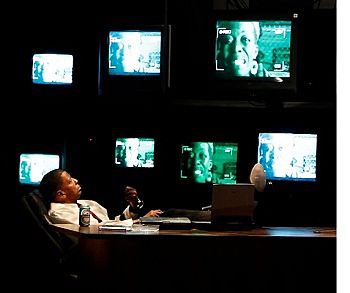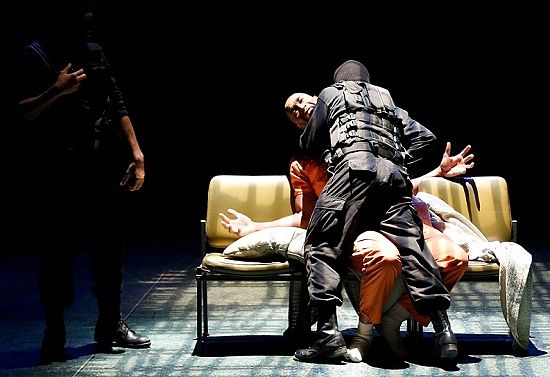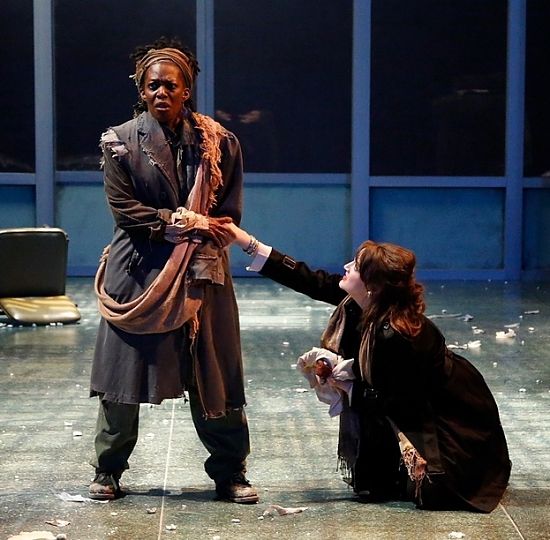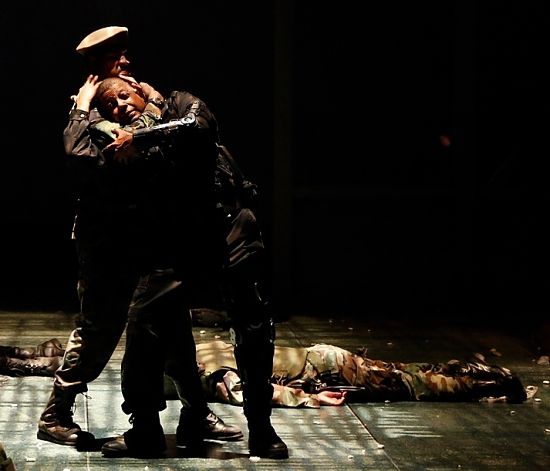Review: Richard III by Texas State University
by Michael Meigs
Richard III is a portrait of a monster. He's a killer, more forthright than Iago and without a shred of the scruples of Macbeth. This is the protagonist who tells us he's going to court a grieving royal widow as she stands over her husband's body "though I kill'd her husband and her father," and achieves that impossibility. She agrees to marry him.
Richard III was the portrait of a sociopath before the diagnosis was invented, the story of a demon in human form. The single-mindedness of Richard's evil is grotesque, and if this story hadn't been presented in Shakespeare's verse, it might have been worth little more than the script for the prancing devil of a provincial church pageant.
A further complication is that this 1592 play opens in medias res -- it's a direct continuation of Shakespeare's galumphing first three plays, Henry VI, parts one through three, in which the Yorks and the Lancasters fight it out. A director may be tempted simply to assume all that background away, throwing his audience directly into the maw of this deformed and demented protagonist with his memorable opening line "Now is the winter of our discontent." American audiences, especially university audiences, certainly can't tell a white rose from a red one. It was all a long time ago and in England, and who cares, anyway?
 Director Chuck Ney's ingenious approach to establishing this dense plot line and making us care about it is to situate it in an unspecified airport. While waiting for the action to start, we hear the distant crossing whine of landing airliners. When the lights come up, we find ourselves in a shabby security room with banks of old-fashioned television sets.
Director Chuck Ney's ingenious approach to establishing this dense plot line and making us care about it is to situate it in an unspecified airport. While waiting for the action to start, we hear the distant crossing whine of landing airliners. When the lights come up, we find ourselves in a shabby security room with banks of old-fashioned television sets.
Eugene Lee has a remote control in hand, and after he settles his twisted figure into an office chair, pops a can of Heineken and hits the button, those TVs come alive. We see brief videos in multiple images across all those televisions, recording the confrontation when Richard gunned down the Lancaster Prince of Wales, the ceremonial accession of Richard's brother Edward and the shrill denunciations of widowed Queen Margaret. There's an equatorial third-world look to all of it, and many of the faces are those of people of color.
The texts of these videos are taken from the final scenes of the Henry VI plays. By this point, before Richard speaks directly to the audience, spectators understand that bloody business has been underway, Richard's an unrepentant murderer, the reigning king is no saint, and the ousted queen is ferocious and bereaved.
Ney's deivce of setting this all in the neutral in-between world of an airport gives us something contemporary to which we can all relate. I thought inevitably of Idi Amin, including the absurd trick of the Israeli commandos at Entebbe Airport, but we've all seen countless television scenes of blood, rebellion and conquering ragtag troops dressed in camouflage fabric. This we think we know. And between scenes and in transitions a parade of arriving passengers files through the glassed-in corridors at center stage, wittily differentiated and characterized as they cross the central performance space and pass from view. The security guard with the red beret and the automatic rifle watches them go.
Scenic and costume design by Michelle delivers that visual world with great clarity. The play is too specific to be contained permanently in airport world, but the very neutrality of the setting lends itself to dream-like transformation. With the lighting design of Sarah EC Maines, center stage transforms into the Tower of London with little more than a shift of furniture and a stark, isolating lighting effect emphasizing prison bars as we witness the assassination of Clarence. A glassed-off room at stage left becomes a multipurpose chamber where King Edward dies -- after an unsuccessful attempt at defibrillation -- and later the two young princes are shot to death by an assassin, leaving the window streaked with blood. The text retains all of its references to English and French place names, but by the time the armies pitch their tents and prepare for battle, we've been carried wholesale into the world without boundaries director Ney and his fellow artists have prepared for these characters.

But forget the setting for a moment; the electric acting is what makes us believe and care about Richard and his victims. Veteran actor Eugene Lee swaggers, glowers and rebukes -- but by addressing us from the first, he turns us into his unwilling confederates. At his most duplicitous moments he embraces someone in feigned truce, but he gives us a canny glance to reassure us that he's not abandoning his embrace of evil. This is an energetic, assured performance, and Lee is articulate, wicked and convincing throughout.
The other Equity guest actor in this cast is Nadine Mozon as Queen Margaret. Though she is reduced to the scruffy appearance of a homeless person dragging all her possessions through the airport, she is an overwhelming, epic presence. Mozon rises to the emotional pitch of the Furies, and those distinctive features, high cheekbones and expressive eyes become the hot incarnation of angry suffering. Perhaps you saw her in mid-2011 when she played the sweetly naive Grace, opposite Lee in Zach's production of Suzann Lori-Parks' The Book of Grace; if so, you will not recognize her here.

This is a huge cast, with more than thirty named characters and another ten in the ensemble who portray nurses, flight attendants, passengers and soldiers. Among the most memorable of them are Alex Zeto as Queen Elizabeth, wife of the infirm King Edward; Andraes Hunt as Clarence, murdered in the tower upon the orders of his brother Richard; Zeke Mills as Buckingham, Richard's eventual nemesis; Johnique Mitchell as Richard's mother, ailing and infirm, who bitterly repudiates him; Nicholas Lawson as Lord Stanley, forced by hostage taking to support Richard; and Zuhdi Boueri as Richard's right-hand man Catesby.
The program for Richard III is particularly useful as a teaching document. In addition to a synopsis of the action -- unfortunately as opaque as almost any other synopsis of a Shakespeare history -- it contains a helpful note by Joe Falocco, who adapted the text, one of Shakespeare's longest, and an account of the history of performance and adaptations of text.

A single regret: this monumental production is being presented for only six performances, which makes the work of a reviewer triply difficult and doubly unfortunate. It closes Sunday evening at 7 p.m. By the time you read this, it may already be gone.
Actor, writer, and director Robert Faires saw the performance, probably on Thursday, February 15, and did his best to raise the alert by Facebook. "Texas State University is running a fine production of RICHARD III this week. Caught it last night, and the rewards of the staging more than make up for the 40 minutes you have to spend on I-35 getting to San Marcos. Chuck Ney's contemporary Third World setting is well thought through, and every student in the 30-member cast really lives in that world, which is tense and immediate and lorded over by a commanding Eugene Lee as the grasping, conniving Richard. The airport setting by Michelle Ney works beautifully and sets up some stunning visual moments, especially the death of Edward and murder of the princes. And a compelling performance by Nadine Mozon as Margaret. RICHARD III isn't on my list of favorite Shakespearean plays, but I highly recommend this production."
EXTRA
Click to view the program for Richard III at Texas State University
Hits as of 2015 03 01: 1237
Richard III
by William Shakespeare
Texas State University Department of Theatre, Dance and Film
